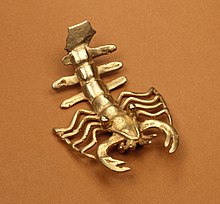
Panama is a country located in Caribbean, bordering both the Caribbean Sea and the Pacific Ocean, between Colombia and Costa Rica. Panama is located on the narrow and low Isthmus of Panama.

Chiriquí is a province of Panama located on the western coast; it is the second most developed province in the country, after the Panamá Province. Its capital is the city of David. It has a total area of 6,490.9 km2, with a population of 471,071 as of the year 2023. The province of Chiriquí is bordered to the north by the province of Bocas del Toro, to the west by Costa Rica, to the east by the province of Veraguas, and to the south by the Pacific Ocean, specifically the Gulf of Chiriquí.
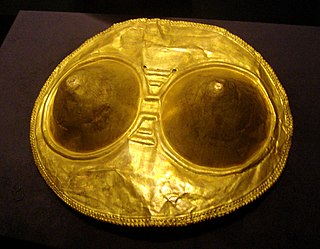
Tumbaga is the name given by Spanish Conquistadors for a non-specific alloy of gold and copper, and metals composed of these elements. Pieces made of tumbaga were widely found in pre-Columbian Mesoamerica in North America and South America.

Tairona or Tayrona was a Pre-Columbian culture of Colombia, which consisted in a group of chiefdoms in the region of Sierra Nevada de Santa Marta in present-day Cesar, Magdalena and La Guajira Departments of Colombia, South America, which goes back at least to the 1st century AD and had significant demographic growth around the 11th century.

Guanín is an alloy of copper, gold and silver, similar to red gold, used in pre-Columbian central America. The name guanín is taken from the language of the Taíno people, who prized it for its reddish color, brilliant shine, and unique smell, and associated it with both worldly and supernatural power. It was also known as taguagua, and in South America as tumbaga. The Spanish referred to it as "low gold", distinguishing it from items made with a higher purity of gold.

A metate is a type or variety of quern, a ground stone tool used for processing grain and seeds. In traditional Mesoamerican cultures, metates are typically used by women who would grind nixtamalized maize and other organic materials during food preparation. Similar artifacts have been found in other regions, such as the sil-batta in Bihar and Jharkhand, India as well as other grinding stones in China.

A Poporo is a device used by indigenous cultures in present and pre-Columbian South America for storage of small amounts of lime produced from burnt and crushed sea-shells. It consists of two pieces: the receptacle and the lid, which includes a pin that is used to carry the lime to the mouth while a person is chewing coca leaves. Since the chewing of coca is sacred for the indigenous people, the poporos are also believed to have mystical powers and social status.

The Quimbaya (/kɪmbaɪa/) were a small, ancient indigenous group in present-day Colombia noted for their gold work characterized by technical accuracy and detailed designs. The majority of the gold work is made in tumbaga alloy, with 30% copper, which colours the pieces.
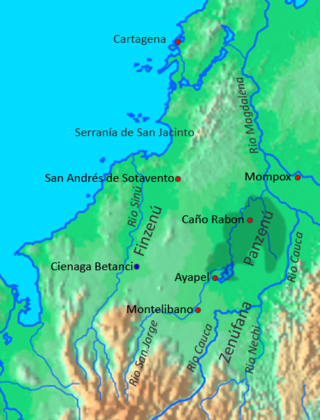
The Zenú or Sinú is a pre-Columbian culture in Colombia, whose ancestral territory comprises the valleys of the Sinú and San Jorge rivers as well as the coast of the Caribbean around the Gulf of Morrosquillo. These lands lie within the departments of Córdoba and Sucre.

The visual arts of the Indigenous peoples of the Americas encompasses the visual artistic practices of the Indigenous peoples of the Americas from ancient times to the present. These include works from South America and North America, which includes Central America and Greenland. The Siberian Yupiit, who have great cultural overlap with Native Alaskan Yupiit, are also included.

Metallurgy in pre-Columbian America is the extraction, purification and alloying of metals and metal crafting by Indigenous peoples of the Americas prior to European contact in the late 15th century. Indigenous Americans had been using native metals from ancient times, with recent finds of gold artifacts in the Andean region dated to 2155–1936 BC, and North American copper finds being dated to approximately 5000 BC. The metal would have been found in nature without the need for smelting, and shaped into the desired form using hot and cold hammering without chemical alteration or alloying. To date "no one has found evidence that points to the use of melting, smelting and casting in prehistoric eastern North America."

Sitio Conte is an archaeological site located in the Coclé province of Panama near Parita Bay. It can best be described as a necropolis and a "paradigmatic example of a ranked or chiefdom society". Based on dates from the goldwork and polychrome ceramics found at the site, its use is dated from approximately AD 450–900. While the site has remained untouched since the final excavations in 1940, its mortuary remains are considered to be a critical resource to archaeologists, as they aid in the interpretation of the social dynamics in the region between AD 500 and 1500.
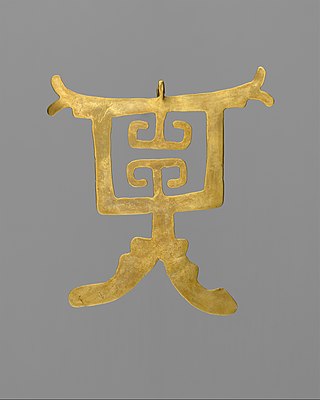
The Capulí culture refers to an archaeological classification for a group in Pre-Columbian South America on the Andean plain in what is now northern Ecuador and southern Colombia. The Capulí preceded the Piartal and Tuza cultures in the archaeological record ranging from around 800 to 1500 CE. The Capulí culture left a strong record through its pottery. The Capulí had distinctive black on dark red pottery with rectilinear geometric designs. The anthropomorphic pottery statues of the Capulí can be striking. Women are depicted with a wrap that extends from the armpit to the ankle while men have loincloths and are often shown with an object such as a drum or animal. These figures are often called coqueros because they are depicted with wads of coca leaves in their mouths. Scholars have associated the figures with shamans and possible funerary rituals.

The Muisca raft, sometimes referred to as the Golden Raft of El Dorado, is a pre-Columbian votive piece created by the Muisca, an indigenous people of Colombia in the Eastern Ranges of the Colombian Andes. The piece probably refers to the gold offering ceremony described in the legend of El Dorado, which occasionally took place at Lake Guatavita. In this ritual, the new chief (zipa), who was aboard a raft and covered with gold dust, tossed gold objects into the lake as offerings to the gods, before immersing himself into the lake. The figure was created between 1295 and 1410 AD by lost-wax casting in an alloy of gold with silver and copper. The raft was part of an offering that was placed in a cave in the municipality of Pasca. Since its discovery in 1969, the Muisca raft has become a national emblem for Colombia and has been depicted on postage stamps. The piece is exhibited at the Gold Museum in Bogotá.

The Diquis culture was a pre-Columbian indigenous culture of Costa Rica that flourished from AD 700 to 1530. The word "diquís" means "great waters" or "great river" in the Boruca language. The Diquis formed part of the Greater Chiriqui culture that spanned from southern Costa Rica to western Panama.

Quimbaya artifacts refer to a range of primarily ceramic and gold objects surviving from the Quimbaya civilisation, one of many pre-Columbian cultures of Colombia inhabiting the Middle Cauca River valley and southern Antioquian region of modern-day Colombia. The artifacts are believed to have originated during the Classical Quimbaya period 500 BC–600 AD.
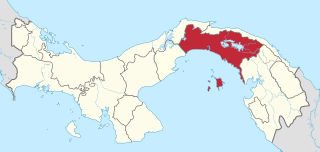
Venado Beach is a Pre-Columbian archaeological site on the Pacific coast of Panama. Named for the Venado River, near whose mouth it was found, the site was excavated by Samuel Kirkland Lothrop, Neville A. Harte and Lt. Col. Montgomery in 1951. Venado Beach is part of the Gran Coclé culture. This site is notable for its large number and variety of burials and grave goods, especially those with offerings objects of gold and evidence for human sacrifice. Radiocarbon dating places the principal occupation of this site at AD 200-900

A tunjo is a small anthropomorphic or zoomorphic figure elaborated by the Muisca as part of their art. Tunjos were made of gold or tumbaga; a gold-silver-copper alloy. The Muisca used their tunjos in various instances in their religion and the small votive offering figures have been found in various places on the Altiplano Cundiboyacense, Colombia. Tunjos were used as offer pieces, to communicate with the gods and when the Muisca asked for favours from their deities. Muisca scholar Pedro Simón wrote about the tunjos of the Muisca.

This article describes the art produced by the Muisca. The Muisca established one of the four grand civilisations of the pre-Columbian Americas on the Altiplano Cundiboyacense in present-day central Colombia. Their various forms of art have been described in detail and include pottery, textiles, body art, hieroglyphs and rock art. While their architecture was modest compared to the Inca, Aztec and Maya civilisations, the Muisca are best known for their skilled goldworking. The Museo del Oro in the Colombian capital Bogotá houses the biggest collection of golden objects in the world, from various Colombian cultures including the Muisca.

The pre-Columbian cultures of Colombia refers to the ancient cultures and civilizations of Colombia.

